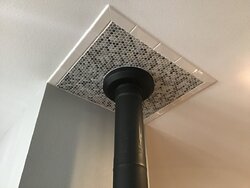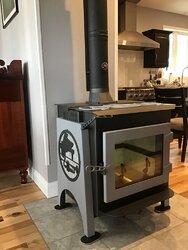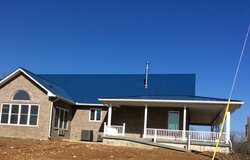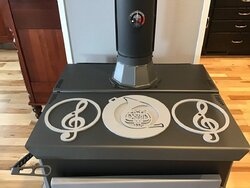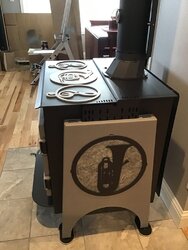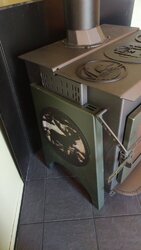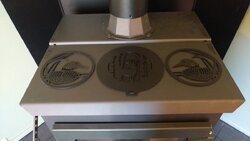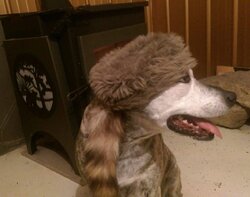I posted a thread a few months ago at the onset of some stove research (titled Lopi or Jotul) and did indeed receive extremely valued feedback on all fronts. I've since been looking in on this forum and still picking up new information. Whoever thought burning a fire could be so thought provoking? I suppose that's why our very early ancestors came up with the idea.
I'm about to finalize a decision to purchase an Ideal Steel stove and would just like a bit more feedback before making that jump.
Structurally wise, one thing that I did notice in the owner's manual was that the door is made of steel and not cast iron. It seems as though any other steel stoves that I've researched have cast iron doors. Simply enough, is that anything to be concerned about? I did ask Woodstock about it and they didn't seem to think it was of any concern. I suppose it may just get a little hotter than a cast iron door but it appears as though they have a pretty good door handle make up. Door action and integrity seem to me to be a rather essential component of a stove since it is about the only moving part and subject to any sort of abuse. I suppose I'm thinking mostly about potential warping......opening, closing, temperature change, etc......Perhaps this is just called over-thinking???
Another more outstanding and serious concern I have is that of draft. Just read a recent post about someone (Ideal Steel owner),with some potential draft concerns and a chimney something like mine as far as height goes anyway. I have a center chimney, 30 to 35 feet, with 7 inch square tile and do get a hell of a draft, especially when cold and when ya really want to load 'er up and get her cranking......
Coming from a home made stove that I can nearly say, I treat as I would a campfire, I realize I may want to adjust my firing technique.
Rather than, load it up, let er rip, damper it down, and walk away, (a bit exaggerated,) I realize I'll need to pay closer attention to temps and burn. Sounds like you can burn pretty low and slow, ( just about smolder?) with a cat. Sounds too good to be true. All this, I will learn in time, and adjustment, Just want to be sure this is the right stove for my needs.
I suppose, without any real world experience in cat stove operation, I can't say I have any direct questions beyond this point, but wait a minute, I'm sure to have many.
Woodstock does offer an ideal amount of information on catalytic burning technique on their website as well as info from here and elsewhere.
Would love to hear from any existing Ideal Steel or "new to" catalytic combuster owners, especially as to what your greatest challenges and successes are or were.
I'm about to finalize a decision to purchase an Ideal Steel stove and would just like a bit more feedback before making that jump.
Structurally wise, one thing that I did notice in the owner's manual was that the door is made of steel and not cast iron. It seems as though any other steel stoves that I've researched have cast iron doors. Simply enough, is that anything to be concerned about? I did ask Woodstock about it and they didn't seem to think it was of any concern. I suppose it may just get a little hotter than a cast iron door but it appears as though they have a pretty good door handle make up. Door action and integrity seem to me to be a rather essential component of a stove since it is about the only moving part and subject to any sort of abuse. I suppose I'm thinking mostly about potential warping......opening, closing, temperature change, etc......Perhaps this is just called over-thinking???
Another more outstanding and serious concern I have is that of draft. Just read a recent post about someone (Ideal Steel owner),with some potential draft concerns and a chimney something like mine as far as height goes anyway. I have a center chimney, 30 to 35 feet, with 7 inch square tile and do get a hell of a draft, especially when cold and when ya really want to load 'er up and get her cranking......
Coming from a home made stove that I can nearly say, I treat as I would a campfire, I realize I may want to adjust my firing technique.
Rather than, load it up, let er rip, damper it down, and walk away, (a bit exaggerated,) I realize I'll need to pay closer attention to temps and burn. Sounds like you can burn pretty low and slow, ( just about smolder?) with a cat. Sounds too good to be true. All this, I will learn in time, and adjustment, Just want to be sure this is the right stove for my needs.
I suppose, without any real world experience in cat stove operation, I can't say I have any direct questions beyond this point, but wait a minute, I'm sure to have many.
Woodstock does offer an ideal amount of information on catalytic burning technique on their website as well as info from here and elsewhere.
Would love to hear from any existing Ideal Steel or "new to" catalytic combuster owners, especially as to what your greatest challenges and successes are or were.


